Words Enhanced by Art
Graphic Novels Reviewed
Why do people love graphic novels so much? What is the draw of this “alternate storytelling”? For many, the pictures add a new sort of depth to literature, another layer in the way tales present themselves. Some words simply need art to help tell their narrative, and are all the better for it. Read one of these six graphic novels, whose stories were made better by art, reviewed in our September/October 2017 issue.
Diary of a Reluctant Dreamer
Undocumented Vignettes from a Pre-American Life
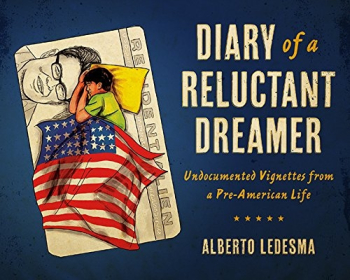
Alberto Ledesma
Mad Creek Books/The Ohio State University Press
Softcover $17.95 (127pp)
978-0-8142-5440-0
Buy: Local Bookstore (Bookshop), Amazon
What is it like to live in America as an undocumented immigrant? Alberto Ledesma shares his own story of struggle and, eventually, US citizenship in his collection of graphic vignettes, Diary of a Reluctant Dreamer.
Although Ledesma’s story has a happy ending largely because of the Immigration Reform and Control Act of 1986, through which he and his family gained amnesty, his experiences still inform the current debate.
Ledesma, who went on to become a university professor and administrator, writes short narratives about the paranoia and stress of living with the constant threat of deportation—experienced not just by him but by his family and countless others. He repeatedly refers to himself as “the perpetually smiling, self-effacing immigrant Cantinflas, who deflected insults as if they were the most natural and innocent wisps of autumn air.”
Ledesma’s art is not in the style of panel-to-panel storytelling but rather of single drawings with text that together encapsulate an idea—like a political cartoon, but with a more serious approach. He addresses the emotions of, and obstacles to, undocumented immigrants achieving their dreams. His portraits are mostly realistic, though they sometimes utilize famous cartoon figures, including Winnie-the-Pooh, Mr. Magoo, and Wile E. Coyote.
Ledesma acknowledges that many people do not view the undocumented experience as a valid aspect of American life, but he makes a passionate case for the opposite viewpoint. Diary of a Reluctant Dreamer is an eye-opening glimpse into a mostly hidden way of life.
PETER DABBENE (August 27, 2017)
Jeff Steinberg
Champion of Earth
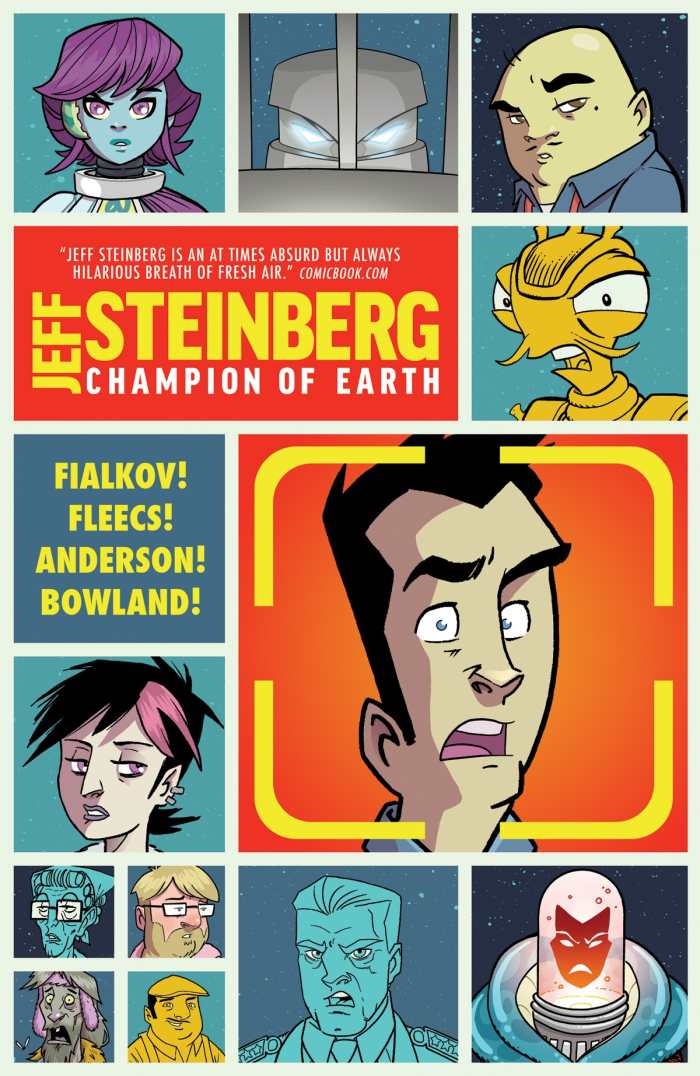
Joshua Hale Fialkov
Tony Fleecs, author, illustrator
Oni Press
Softcover $19.99 (176pp)
978-1-62010-431-6
Buy: Local Bookstore (Bookshop), Amazon
A video-store clerk is the only one who can save the Earth in the slacker-comedy graphic novel Jeff Steinberg: Champion of Earth.
By fluke, Jeff Steinberg—a thoroughly mediocre person—is chosen by aliens to compete in a contest to determine Earth’s fate. Steinberg reluctantly fills the role while the world jokes about his inadequacies and looks for another way to save the planet. But Jeff finally defeats his foe, only to find that there are even more waiting.
Although there are plenty of funny moments throughout the book, the story sometimes feels as though it’s been retrieved from a musty file cabinet. The opening banner sets the story at “next Thursday, 9:30 AM,” which, combined with President Obama talking about “going out on top” and a reference to the 2011 Green Lantern film, marks it as somewhat current.
Yet the title character is a twentysomething who works at a video store and refers to ’80s and ’90s movies like The Karate Kid, Dave, The American President, and Back to School. The story, and many of the jokes, revolve around VCRs and VHS copies of movies, the TV series The Cosby Show, Windows ME, and mixtape CDs.
While the retro-humor might not appeal to some audiences, others will love it. Equally polarizing are the story’s characters, few of whom are classically “likable”—even Jeff seems equally motivated to fight by thoughts of impressing an unfaithful girlfriend, and the prospect of winning free dinners for a month.
Jeff Steinberg: Champion of Earth isn’t a grand heroic epic, but it succeeds as a vehicle for frequent punch lines and entertaining wackiness.
PETER DABBENE (August 27, 2017)
Lighter Than My Shadow
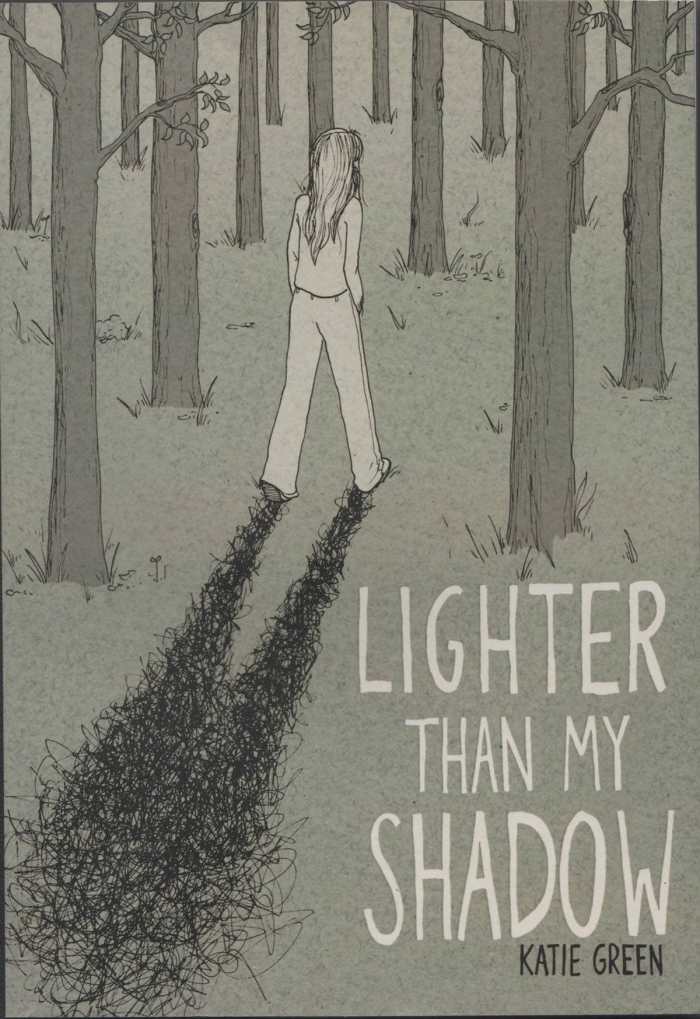
Katie Green
Lion Forge
Softcover $19.99 (516pp)
978-1-941302-41-5
Buy: Amazon
Katie Green’s memoir, Lighter Than My Shadow, offers a personal, finely wrought examination of life with an eating disorder, as well as of the repercussions of abuse.
Warning signs appear early. Young Katie seems obsessed with perfection, particularly with regard to her body image and tracking what she eats. When the problem manifests itself outwardly and Katie is diagnosed with anorexia, her parents consult an “alternative therapist” who betrays Katie’s trust and adds another layer of emotional obstacles for her to overcome.
Green’s account is revealing, not just in its unguarded disclosures of events in her life but also in its exploration of what takes a smart girl from a supportive family down such a difficult path.
Katie is a sympathetic, almost tragic figure as she cycles from one round of “recovery” to another and is nearly undone by the process. Finally, she achieves a delicate balance that allows her to move on with her life as an artist.
Green’s drawings capture feelings that her words alone cannot. There’s no substitute for the visceral reaction to witnessing the shocking changes in Katie’s body or seeing her doubts, fear, and obsessions manifested in the form of a black cloud, or shadow, that appears throughout the book—sometimes small, sometimes completely enveloping her.
Lighter Than My Shadow features some adult content but is insightful and valuable for those of high-school age or even younger. It’s a gripping memoir that survivors can relate to, and one that will produce a greater degree of empathy and understanding in those who have little experience with the subject.
PETER DABBENE (August 27, 2017)
Marco Polo
Dangers and Visions
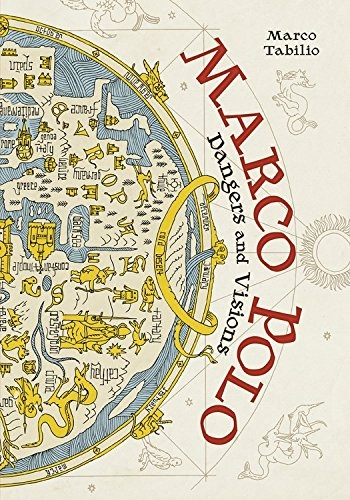
Marco Tabilio
Graphic Universe
Softcover $11.99 (208pp)
978-1-5124-3069-1
Buy: Local Bookstore (Bookshop), Amazon
Marco Tabilio’s gorgeous graphic novel Marco Polo vividly relates the story of the famed explorer.
This graphic biography encompasses Polo’s whole life, showing not just his time in the court of Kublai Khan but also the influences of his family on his chosen path as a traveling merchant. It sheds light on the lesser-known events of his later days as well, including time spent as a captain in the Venetian fleet and, following the defeat of those forces, his time spent in jail.
From his cell, Polo narrates the story of his travels to Rustichello, a fellow prisoner and the eventual coauthor of The Travels of Marco Polo. As Rustichello tells Marco, “You have the story. I have the pen. You talk. I’ll write. It will be a fantastic tale.”
It is. As portrayed through Tabilio’s hand, Marco Polo is a vividly rendered, humanized figure, full of doubts and fears, loves and aspirations.
Tabilio’s art is highly stylized. Characters have blank eyes reminiscent of Little Orphan Annie; most pages are colored in monochrome, with different hues used to indicate different locations or time periods; and there are several elaborate, hand-drawn maps. Yet the storytelling is always clear, and the tale itself is grounded in Polo’s actual accounts.
Marco Polo: Dangers and Visions captures the excitement and spirit of exploration that have kept Polo’s name and stories relevant, even as the world seems to get smaller.
PETER DABBENE (August 27, 2017)
Poppies of Iraq
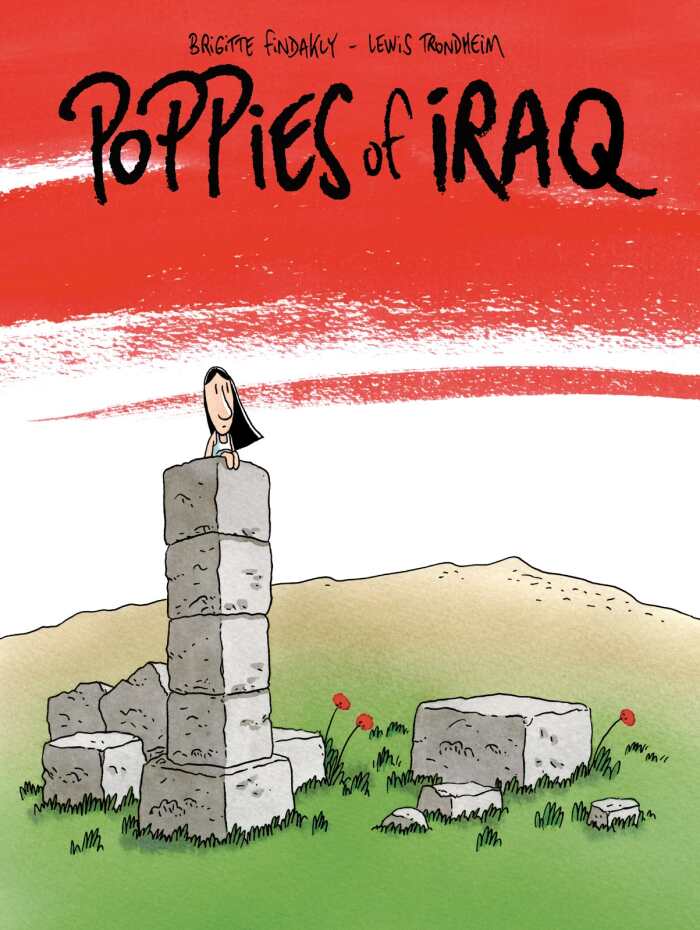
Brigitte Findakly
Lewis Trondheim, illustrator
Drawn and Quarterly
Hardcover $21.95 (120pp)
978-1-77046-293-9
Buy: Local Bookstore (Bookshop), Amazon
Brigitte Findakly, along with her husband, cartoonist Lewis Trondheim, provides perspective on the history of Iraq through her graphic memoir, Poppies of Iraq.
Findakly grew up in Iraq. Her book begins with a memory of visiting the historical site of Nimrud as a girl, and a quick mention of the fact that the site’s famous winged lions have since been destroyed by the group Daesh, or ISIL.
This brief study in contrasts creates the framework for the book. Findakly continues to recount small, sometimes fond memories, and to note changes to those landscape over time; or, with the wisdom and clarity of hindsight, she reflects on the larger forces at work during those periods.
Here, then, is a firsthand account of the everyday impact of political change—coups and counter-coups, the rise of Saddam Hussein, and the Iran-Iraq War—as seen through one woman’s eyes.
Trondheim’s illustrations give a clear sense of life in Iraq, and the combination of art and text is more powerful than either could be on its own. Both focus on the domestic and personal aspects of living in Iraq, which brings emotional weight to Findakly’s experience and results in a greater impact than any mere history lesson could make.
Poppies of Iraq was first serialized in the French newspaper Le Monde; this translation from Helge Dascher gives the English-speaking world access, via a unique window, to the people and practices of what can sometimes seem a very foreign land.
PETER DABBENE (August 27, 2017)
Pantheon
The True Story of the Egyptian Dieties
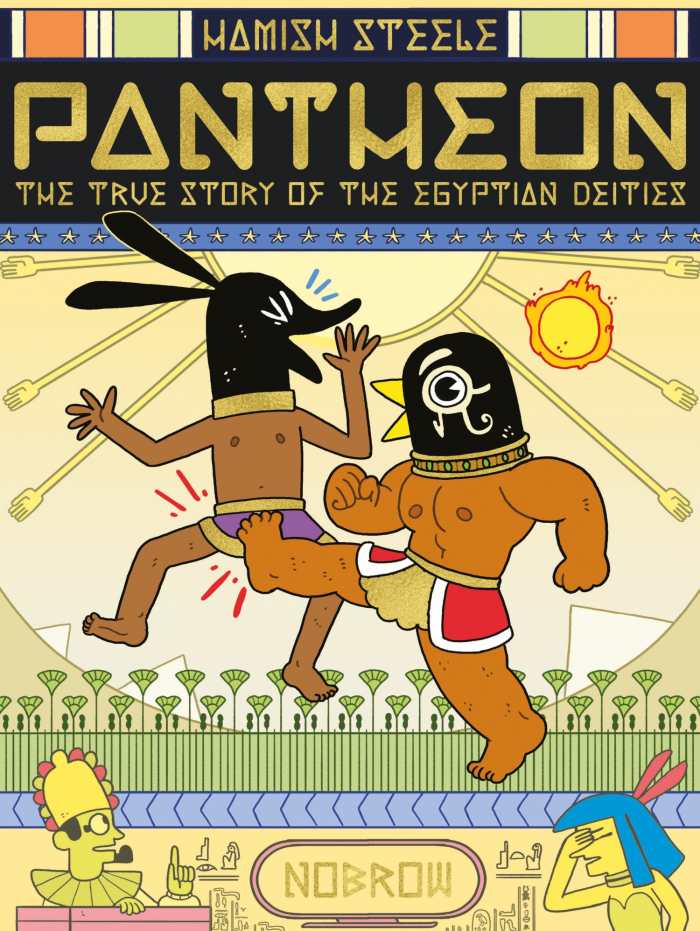
Hamish Steele
Nobrow Press
Softcover $22.95 (216pp)
978-1-910620-20-5
Buy: Amazon
Hamish Steele presents a coherent story about how all the Egyptian gods fit together, in his humorous, irreverent graphic novel Pantheon.
Beginning with a handy family tree of Egyptian gods, Pantheon weaves accounts from various ancient documents into a surprisingly faithful and cohesive tale. The gods are often petty or stupid, which, combined with their power, makes for an extremely entertaining, slightly surreal soap opera.
“Fart for your life, my son!” Isis implores Horus, bringing a sense of humor to the book. Both the art and the text are simple but effective. Using distinctions of color and accoutrements, Steele keeps a multitude of deities easily discernible. Dialogue is delivered in modern-day vernacular (including curses), helping a somewhat convoluted chain of events to flow nicely.
A celestial cow, the first mummy, magic scorpions, incest, and a boat race—the crazy and contradictory somehow make sense here. Characters change their minds frequently and give in to their emotions and desires on a whim. As Steele theorizes near the end of the book, perhaps these gods were created not simply to inspire awe or explain natural phenomena but also to entertain and instruct through their mistakes.
It’s a good bet that this raucous, ribald, laugh-out-loud graphic novel will keep the stories and lessons of the Egyptian pantheon alive in the minds of current and future generations.
PETER DABBENE (August 27, 2017)
Peter Dabbene

